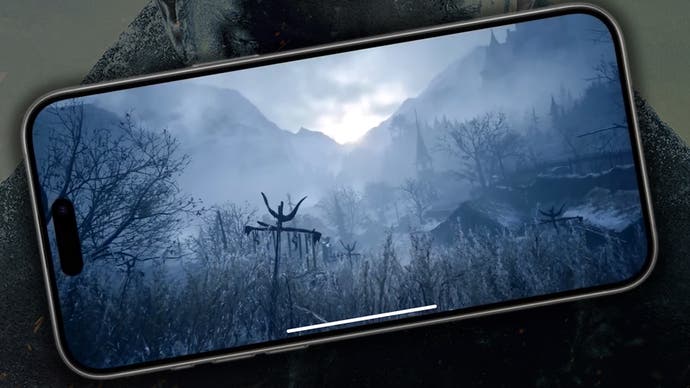Triple-A games are coming to iPhone 15 Pro - and the implications are mouthwatering
A compelling unified Apple ecosystem for top-end games takes shape.
Triple-A gaming on mobile phones? Up until now, the chances of it happening seemed vanishingly slight owing to the sheer range of hardware with a staggering breadth of horsepower and the correspondingly fragmented audience. Why attempt to port a game like Death Stranding to a phone if the vast majority of the audience can't run it? And do games like Death Stranding actually work as a mobile experience to begin with? We're about to find out, as last week's Apple keynote revealed two new iPhones - the iPhone 15 Pro and iPhone 15 Pro Max - running games including Resident Evil 4, Resident Evil Village, Assassin's Creed Mirage and, yes, Death Stranding.
Apple says this is all made possible owing to the new GPU found within its cutting-edge A17 Pro silicon - the first 3nm processor to hit a mainstream consumer device. That GPU supports hardware-accelerated ray tracing on top of a mooted 20 percent increase in general performance over its predecessor. The A17 Pro in general looks phenomenal, adding further CPU horsepower to its already market-leading performance, along with a larger, faster Neural Engine. Accelerated machine learning features? That'll be useful for the Metal FX upscaler, which we've already seen working on Mac, delivering results comparable with the market-leading Nvidia DLSS.
Other features of the iPhone 15 Pro range also impress, with a 120Hz variable refresh rate display, HDR and a relatively manageable screen resolution. Combined with Metal FX upscaling, the A17 Pro should be able to deliver a good level of GPU horsepower per pixel while retaining excellent image quality. This topic is just one of a range of items covered in the new DF Direct Weekly, conveniently posted for your audiovisual enjoyment below.
- 0:00:00 Introduction
- 0:01:35 News 01: Sony September State of Play
- 0:37:42 News 02: September Nintendo Direct
- 0:49:58 News 03: Starfield post-release update plans detailed!
- 0:55:03 News 04: Horizon Forbidden West to hit PC?
- 0:59:04 News 05: Immortals of Aveum patched, developer cuts staff
- 1:07:16 News 06: iPhone 15 Pro gets ray tracing support, big budget games
- 1:15:16 Supporter Q1: With compromised releases like Jedi: Survivor, don't publishers realize they are leaving sales on the table? And will Respawn disable some of the game’s problematic screen-space reflections?
- 1:23:21 Supporter Q2: Are the higher-end versions of a given graphics card worth it?
- 1:27:30 Supporter Q3: Which GPU of the past gave you the feeling that it was a quality product?
- 1:31:22 Supporter Q4: Is it possible that the Switch 2 could exceed the RT abilities of current-gen consoles?
- 1:34:25 Supporter Q5: Now that the PS5 Pro rumours have firmed up, do you think the console is worthwhile?
- 1:41:11 Supporter Q6: What is something happening in gaming right now that makes you happy?
So, the hardware is there to get the job done and by strictly defining these titles for A17 Pro hardware only, Apple has thrust a stake into the ground about necessary hardware requirements, with no chance of people buying games they can't run. The good news is that as time progresses, those hardware requirements will gradually permeate down to lower-end, more affordable phones. The precedent is already there as the standard iPhone 15 and iPhone 15 Plus are running the A16 Bionic from last year's iPhone 14 Pro flagship.
In terms of the addressable market for developers, there's more good news here as it seems that the ecosystem that delivered Resident Evil Village on Mac makes for easier porting of Mac versions of games to iPhone. In being able to bring expensive-to-develop games to iPhone, developers and publishers also stand to benefit from an increasing market delivered by the continuing sales of higher-end Apple cellphones while also supporting the Mac platform. A more fully formed ecosystem is developing that suddenly makes development for all modern Apple devices a lot more appealing.
In terms of consumer excitement about this announcement, I can only offer anecdotal evidence but certainly in terms of the questions posed by the Digital Foundry supporters for this week's DF Direct Weekly, it was by far the most popular topic. We had more questions about this announcement than we did about the PlayStation State of Play or the Nintendo Direct.
The question is: can the iPhone 15 Pro and Pro Max deliver good experiences on higher-end games? Bearing in mind screen resolutions, Metal FX upscaling and the raw horsepower provided by the best-in-class Apple Silicon, I'd say the chances are good. The only potential fly in the ointment concerns sustained performance. The longer a mobile processor runs at maximum power, the hotter it becomes, and as smartphones typically don't have active cooling, performance throttles back. The basic idea of putting a phone into a case in order to protect it doesn't exactly help with heat dissipation either.
I'm reminded of a conversation I had back in the day with Epic Games about Fortnite running on iPhone 10. The silicon had the performance to run the game at 60 frames per second - but it was capped at 30fps anyway, to save on battery life and to ensure that the phone didn't overheat. Only when faster, more efficient processors came along did Epic unlock the performance. According to IGN, frame-rate capping at 30fps is in effect on Resident Evil Village at least, and that makes sense.
We're hoping to look at this new wave of games as and when they launch towards the end of this year and the beginning of the next, assuming we can get a decent video output feed from the hardware that doesn't compromise performance - but on a more general level, it would be fantastic to add a new platform to the range of hardware we cover at Digital Foundry.



